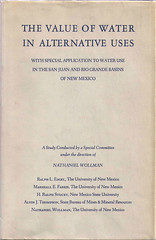I recently scored a fascinating volume at the used bookstore: “The Value of Water in Alternative Uses, With Special Application to Water Use in the San Juan and Rio Grande Basins of New Mexico.” Published in 1962, it’s the result of a study of the economics of various ways of allocating New Mexico’s water.Given that I’ve been writing about this of late, I was intrigued see what people were saying about it 45 years ago. The answer? Pretty much exactly what we’re saying today.
Within roughly one half of the United States – the area from the 100th meridian westward except for the Columbia River basin and adjacent coastal streams – a transfer of water demand from one point to another will have no effect on the over-all shortage, since the entire region’s projected demand for water is substantially greater than the region’s maximum regulated flow.
The issue, then as now, is the competing needs of agriculture and the region’s growing cities. The study was done as the San Juan-Chama project, which brings Colorado River basin water to Albuquerque and the other cities along the Rio Grande, was just getting off ground. The San Juan Basin was dominated by oil and gas, with a “some irrigation farming.” The Rio Grande valley was on the march, “still highly agricultural” but “dominated economically by several military and atomic energy installation”. Then, as now, “all eyes (were) on the San Juan river” to deal with the region’s water needs. The study’s purpose was to rationalize regional use of the San Juan River, which at the time (horror of horrors to western water developers) was largely flowing “unused” out of New Mexico.
How then can judgment be exercised to determine the future growth of a region dependent basically upon a fixed amount of water?
The study’s answer, which echoes what you hear in the water community today – move water from agricultural use to city use. It’s a strictly economic calculation – an acre-foot of water, the study concludes, contributes more than 50 times as much to New Mexico’s gross state product in industrial use (both by the industries themselves and the cities that house their workers) as does an acre-foot used for agriculture.
Given proper planning, there is no reason why such areas as the San Juan and Rio Grande basins should not sustain vastly larger populations, greater industrial growth, increased agricultural output, and the residential amenities and recreational opportunities that are needed for agreeable living.
Agreeable living? Definitely. Proper planning? I think the jury’s still out.


The South Platte basin’s strategy is exactly the same thing. Pathetic, in my view, unless we factor in the fact that humans have no sensory organs to see problems at these scales.
Best,
D